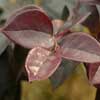|
LONICERA
korolkowii |
|
|
|
|
| LONICERA
periclymenum 'Honeybush' I have planted this wonderful shrub all round the garden in strategic places near to paths. It is distinct from the majority of the species by its none climbing habit. However, the flowers are the familiar red and cream, whilst the scent is seemingly better than ever. Easy to grow anywhere and no pruning is essential, though I tidy them up in the winter. |
|
|
|
|
| LONICERA
purpusii 'Winter Beauty' Large semi evergreen shrub. Masses of fragrant cream flowers all winter. |
|
|
|
|
| LONICERA setifera 'Daphnis' | |
|
|
|
| LONICERA tatarica alba | |
|
These are such
pretty plants. A handsome deciduous shrub to 2m that is related to
Hamamelis (it therefore does not require acid soil so much as good
drainage in the winter but adequate moisture retention in summer). The
long-lasting, fragrant strap like flowers open in April but can be
produced all year round in favourable conditions as the growth ripens.
It needs a sheltered site to perform to its best. |
 |
LOROPETALUM chinense 'Daybreak's
Flame'
The leaves are essentially an olive green with pretty pink tips to the new growth. The pink flowers are reputedly even larger than those of 'Firedance', whilst the habit is similar. |
|
|
|
|
LOROPETALUM
chinense 'Fire Dance' |
|
|
|
|
|
LUMA
apiculata |
|